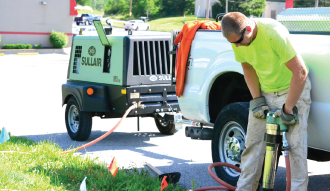 |
Industry Outlook: Compressors
Tier 4 Final rules cause rental centers to rethink models
As Tier 4 Final rules take effect in the portable compressor market, end users and rental centers are rethinking model selection and costs. The technology needed to meet Tier 4 Final rules also brings greater versatility and control to rental houses and their customers.
Pro Contractor Rentals asked compressor experts for their insights on the ever-changing compressor market. Here's what they shared:
 |
|
Josh Goodman, assistant product marketing manager, Doosan Portable Power |
Push to rental over retail
The overall air compressor market is trending toward rental. This correlates with the rising cost of engine technology and maintenance costs related to Tier 4 Final emissions while rental rates have remained steady. Retail customers realize the
longer payback and added cost of emission-related maintenance, which increasingly drives them to a rental solution.
Rental and retail customers rank equipment quality and performance highly in rental decisions. Rental customers and rental centers need versatile air compressors that can perform and hold up to jobsite rigors. Doosan Portable Power answers that call with dual pressure/dual flow models, such as
the P425/HP375WCU-T4F. It’s factory-configured to provide the two most common pressures and flows, and can easily switch from low pressure/high volume to high pressure/low volume at the push of a button. With simple valve adjustment, users can regulate the pressure to match the job at hand.
Utilizing one air compressor for two types of needs helps rental centers keep their ROI in line while providing users the best rental rates. One machine covers many needs versus investing in niche machines for exclusive applications that can drive rental rates higher to achieve the needed ROI.
Doosan Portable Power has also incorporated efficiency into its equipment. One change is a fan clutch in some models that controls the fan based on ambient temperature and the cooling needs of the machine. This lowers the fuel bill in some applications for the rental end user.
 |
|
Zach Switalski, sales director, portable power, Sullair Compressors |
Equipment options based on regional needs
Increasingly, Sullair is receiving requests for Tier 4 Final air compressors, which offer a variety of improved features and benefits and are in compliance with the strictest government regulations. While developing these new models, Sullair developers listened to consumers who reviewed prototypes and offered suggestions.
Our customers are looking for the most efficient, reliable and versatile machines to get the most bang for their buck. The new, compact Tier 4 Final models include updated air ends, proven engines, better fuel efficiency and several components that improve serviceability. They also offer a broader range of pressure, allowing for more jobsite flexibility.
Sullair also has many customers who are happy with their existing Tier 2 and Tier 3 compressors and want to prolong the lives of their fleets. For these customers, Sullair offers two different solutions: reconditioning or remanufacturing.
Under the Sullair Recon reconditioning program, customers can turn in their used 2004 to 2012 750 to 1600 cfm compressor models and Sullair will refurbish them to the owner’s specification. This is a hassle-free way to maintain equipment and keep it running at maximum efficiency.
Sullair also offers a Certified Reman program. Here, the customer receives a like-new machine with a like-new warranty. The customer sends in its old core and quickly receives a fully remanufactured machine with the latest factory revisions. Sullair has recently expanded this program to include large air models.
 |
|
Chance Chartters, |
Regulations require fleet resizing
Tier 4 Final emissions requirements have been a major challenge to the portable compressor industry, compelling manufacturers to significantly change designs to meet the new regulations. The redesign allowed Kaeser to add features that enhance the versatility for end users and help rental houses stay competitive.
Tier 4 Final emissions requirements have greatly increased equipment purchase prices, making 185 cfm compressors too expensive for many rental centers. Kaeser has been helping rental centers migrate to an application-oriented sizing instead of a one-size-fits-most/bigger-is-better mentality. Most compressor rental customers power one tool at a time, so a 90 cfm unit can do the job in most cases.
Kaeser’s new Tier 4 Final 90 cfm compressor costs about as much as a pre-Tier 4 Final 185 cfm compressor, so rental centers are moving to the smaller models. End users benefit from running these smaller, quieter and more economical machines.
The Tier 4 Final-compliant engines use electronics to monitor and manage emissions and are used to integrate and monitor other compressor functions. Kaeser’s Sigma Control smart electronic controller is simple to operate and can help a rental center stay on top of fleet maintenance with programming options, maintenance reminders, service alarms and diagnostic data.
Kaeser uses a roto-molded polyethylene (PE) canopy on several models. It is a much more durable alternative to steel enclosures. PE canopies absorb impact, maintain shape and are impervious to scratches and dents. They weigh less and allow convenient maintenance access. The streamlined and aerodynamic appearance versus the boxy metal box looks better longer, so the compressor looks in great condition and helps rental centers resist downward pressure on rental rates.
 |
|
Steve Scattolini, |
Increasing costs drive new options
Rental rates have not increased to compensate for the increased capital cost of machines. Consequently, some rental centers have chosen to postpone Tier 4 compliance as long as possible while others have exited the air compressor business completely. The limited number of quality used compressors has driven up their price. FTG Equipment, through its Rotair compressor line, offers solutions to these market challenges. Its most popular models are the 185 cfm D185T4F and the 90 cfm D90KA models that offer Tier 4 Final compliance. The Rotair D185T4F is powered by the Kohler KDI1903-TCR engine and the D90KA is powered by the Kubota D1105-E4B engine. Both are true Tier 4 Final-compliant engines instead of pre-Tier 4 Final engines with added components to achieve Tier 4 Final compliance.
While the 185 cfm compressor is viewed as the market staple, the costs of this size of unit has doubled in the past 10 years. As rental stores and users re-evaluate how much air they really need, many are finding a 90 cfm compressor is a viable option, saving capital and increasing ROI.
Rotair compressors have all-steel construction and are built in an ISO 9001-certified facility. The units feature curbside compressor controls and air outlets for maximum operator safety. They are compact and tow easily. With fuel-efficient engines, they have ample runtime on a tank of fuel. Accessories, such as hose reels, can be added easily and the compressors can be outfitted with integrated coolers. All units are available in a towable or skid-mount option. The units are backed by a team that has more than 100 collective years of air compressor-specific experience.
 |
|
Michael Sagerman, |
Downsize for the right size
Overall, the U.S. compressor market has shown stability throughout 2016. But a closer look at individual product channels shows there is a more complex picture that reveals mixed underlying trends of hyper-growth, stability and contraction.
Rental industry professionals have found that more than 50 percent of their 185 cfm compressor rentals include only one pneumatic breaker, which needs 90 to 100 cfm to operate. This means many rental centers are stocking larger than needed compressors. Often, the bigger the compressor, the more fuel it requires and possibly more maintenance, particularly with Tier 4 Final models. Rental centers are looking to balance their mix of single- and double-breaker compressor needs by stocking more 90- to 100-cfm compressors in addition to the traditional 185-cfm models.
Diesel Tier 4 Final compressors cost more and require more maintenance, so many rental centers are looking for solutions that circumvent emissions requirements. They are looking at gasoline- and electric-powered models, which are more cost effective to purchase, operate and maintain because they don’t require additional components to meet Tier 4 Final requirements.
As technology advances, Atlas Copco continues to develop products that help reduce overall cost. Atlas Copco’s new XAS 110 Kd 110 cfm compressor can run either one standard pneumatic 70- to 90-pound breaker or two Atlas Copco RTEX high-efficiency 70-pound class breakers. It is 15 percent smaller than a 185-cfm compressor and is lighter, easier to use and minimizes maintenance when compared with larger models. Its Kubota engine meets Tier 4 Final requirements without an exhaust after-treatment system or diesel particulate filter, which is atypical in the market.
 |
|
Eric Massinon, |
Looking for new solutions
Rental customers are looking for ways to reduce rental rates but demand reliable, efficient products. Rental centers struggle to keep the more expensive Tier 4 Final compressors out on rent enough to cover maintenance costs and achieve a reasonable ROI.
Rental centers are meeting this demand by using completely rebuilt compressors with a new Tier 3 engine. The rebuild compressor/replace engine strategy reduces the cost of the compressors and allows rental yards to maintain lower rental rates, giving them an advantage over competitors. The Chicago Pneumatic rebuild programs have been popular and are now pushing into 185-cfm capacity compressors.
Customers are also exploring the use of smaller, single-tool compressors. This opens the door for the CPS 90 and the new 110-cfm models that Chicago Pneumatic will introduce. The smaller diesel engines cost less because they only need a Diesel Oxidation Catalyst (DOC) to meet Tier 4 Final requirements. The simpler engines help customers avoid potential issues related to new engine technology.
Finally, some users are looking at selecting hydraulic handheld tools in the Chicago Pneumatics line to replace pneumatic tools. Hydraulic tools are smaller and available in a variety of configurations and can be used in smaller contractor rental applications.









